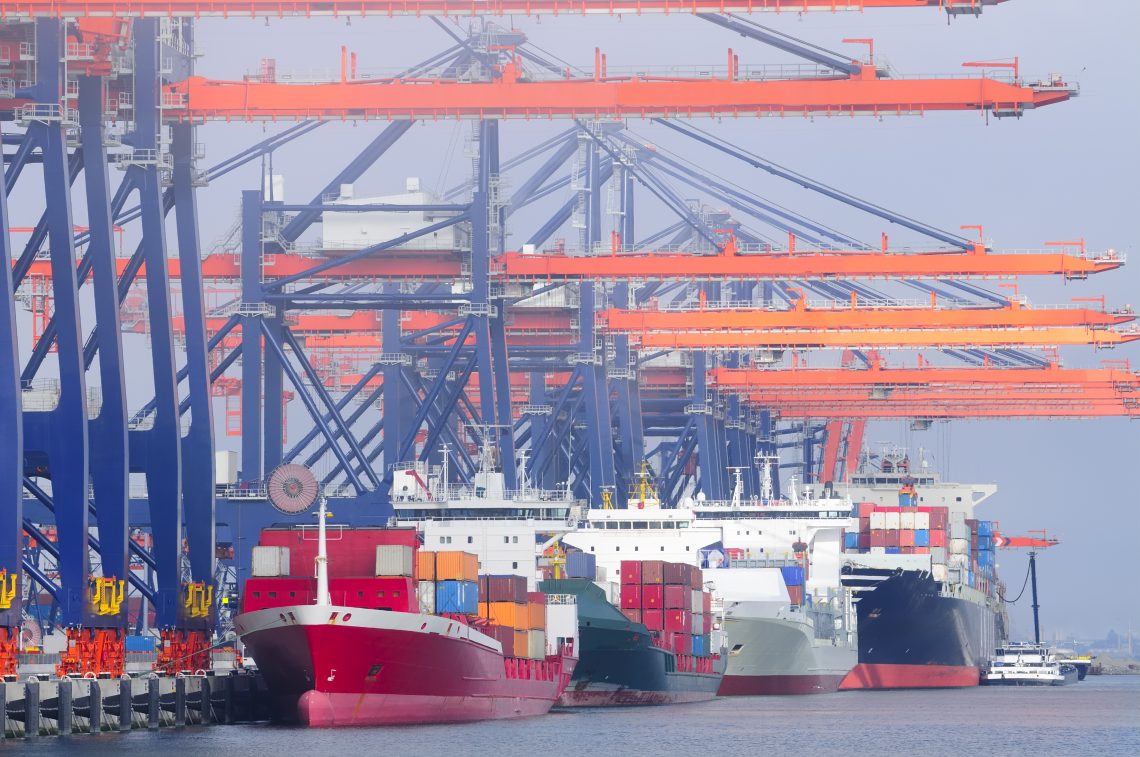The future of U.S.-Europe trade
Trade between the U.S. and the EU is likely to strengthen, even despite shifting geopolitical and geoeconomic winds.

In a nutshell
- The economic relationship is strong, with the trade balance favoring Europe
- If reelected, President Trump’s policies could create uncertainty
- Trade could strengthen or shift toward China; a big decline seems unlikely
The complex and evolving trade relationship between the United States and the European Union is at a pivotal moment, reflecting broader global shifts and geopolitical uncertainties. As two of the world’s largest economies, the U.S. and the EU have long maintained deep economic ties, characterized by significant trade in goods and services, as well as robust foreign direct investment. However, recent years have seen these dynamics challenged by global events such as the Covid-19 pandemic, Russia’s full-scale invasion of Ukraine and the rising influence of China.
The U.S. and Europe have long enjoyed strong economic ties through international trade, although in recent years the balance of trade has been tilted in Europe’s favor: In 2022, the U.S. imported goods and services worth $723 billion from the European Union. In return, the U.S. exported goods and services worth $592 billion to the EU, resulting in a U.S. trade deficit with the EU of about $131 billion. Total U.S. trade with Europe in goods and services was 73.4 percent larger than total U.S. trade with China. Nevertheless, the U.S. trade deficit with China was almost three times as large as the U.S. trade deficit with Europe.
That could change if former President Donald Trump gains reelection this November. His protectionist trade policies, which remain a key aspect of his campaign, will likely focus primarily on China, as was the case in his first term in office between 2017 and 2021. However, there is also a considerable degree of uncertainty around the question of what Mr. Trump’s reelection would imply for the U.S.-EU trade relationship. Over recent decades, no other two major regions in the world have shown stronger ties in terms of trade flows than the U.S. and the EU, but will this relationship endure?
President Trump has openly pondered the idea of introducing a 10 percent tariff on all imports from anywhere in the world – including the EU. Such a universal tariff would be of particular significance for Europe as the most important trading partner of the U.S. Although it is often argued that Mr. Trump advocates tariffs not for their own sake but merely as a threat to impel others to reduce trade barriers, this might just be wishful thinking from those who understand and appreciate the benefits of the international division of labor.
Trade in goods
In 2020, China temporarily became, for the second time after 2010 and 2011, Europe’s largest trading partner when it comes specifically to goods, or tangible items that can be used, stored or consumed. When services are included – where the receiver does not obtain anything tangible through the transaction – the U.S. remained Europe’s biggest trading partner. If the U.S. imposes more restrictions, the trade relationship between Europe and China might be reinforced, continuing a trend observed over the past decades, during which total European trade in goods with China grew from less than 1 percent of gross domestic product (GDP) in 1999 to more than 5 percent in 2022.
European trade in goods with the U.S. initially declined between 1999 until the financial crisis hit in 2007. Since then, there has been a trend reversal: The EU-U.S. trade in goods as a total share of the EU’s GDP has been on the same trajectory as the EU-China trade in goods.
Facts & figures
EU trade in goods with the U.S. and China since 1999

Europe has a sustained and increasing trade surplus with the U.S. when it comes to goods: While imports from the U.S. in 2023 were at about the same level as in 2000, exports as a share of GDP increased by more than 21 percent over the same period. In contrast, with China there is a sustained and increasing trade deficit. Both imports and exports have increased by a factor of more than five, and the deficit has grown from 0.3 percent of GDP in 1999 to 1.7 percent of GDP in 2023.
Trade in services
Trade in services remains dominated by the U.S. The U.S. holds a persistent and increasing trade surplus both with the EU and China. In absolute terms the trade in services is much stronger between the U.S. and the EU than between the U.S. and China, but the fall in service trade after 2019 is much stronger for the EU. In fact, in 2023 U.S.-EU trade in services as a percentage of U.S. GDP had not even returned to its level of 1999 – far less its pre-pandemic level.
Facts & figures
U.S. trade in services with the EU and China

It is precisely in services trade where we can observe, from the end of the first Trump administration to the end of the Biden administration, a decoupling between Europe and the U.S. relative to U.S. GDP. Given that the tie between Europe and the U.S. is also built on services, this development points to a tension in the U.S.-EU relationship with deeper causes than the prospect of Mr. Trump returning to the Oval Office. However, the tension might be exaggerated in the data presented here: In absolute terms, both imports and exports of services between the U.S. and the EU have come closer to pre-pandemic levels. It is only relative to U.S. GDP that a notable difference remains.
Foreign direct investment
The third main indicator of international trade and economic relationships is foreign direct investment (FDI). Slightly more than a quarter of the EU’s FDI outside the bloc is held in the U.S. This share, after some ups and downs, has increased only mildly over the past decade, by about 9 percent. EU foreign direct investment in China accounts for a much smaller share in overall EU external FDI, but has seen a sustained increase since 2017, rising by more than 26 percent in only five years.
There are nuances, however. When Hong Kong as a special economic zone is included, we observe a significant hike before the outbreak of the Covid-19 pandemic that subsequently vanishes. And while the overall trend remains positive, it is possible that the latest data for 2023 will show a trend reversal as a consequence of Western reactions to Russia’s full-scale war on Ukraine, and China’s friendly relationship to Russia.
Scenarios
Forecasts of international trade patterns are even more speculative than economic forecasts in general, as they are highly dependent on political decision-making and geopolitical events that cannot possibly be foreseen accurately. However, there are three scenarios with likelihoods that can be loosely quantified.
Most likely: U.S.-Europe trade will be reinforced
Even in the event of Mr. Trump being elected the next U.S. president, the most likely scenario seems to be that U.S.-EU trade will strengthen. In an ideal world, this could happen alongside improved trade relationships with China and other non-Western countries like India and Russia. After all, China remains a lucrative business partner, as can be seen in the average return on EU foreign direct investment in China – it stood at 13.5 percent in 2022, which indicates a lot of unexploited potential. In contrast, the average return on EU foreign direct investment in the U.S. was only 3.6 percent in 2022. However, if geopolitical tensions continue, Europe will most likely side with the U.S., which implies decoupling from China and other non-Western countries and reinforcing cross-Atlantic trade relationships and cooperation.
Less likely: European trade moves east at the expense of U.S. trade
A more unlikely scenario is that Europe will reorient toward China and other non-Western countries if geopolitical tensions continue, which would imply a gradual decoupling from the U.S. Given the depth and mutual benefits of the transatlantic relationship, it seems very unlikely that European decision-makers would judge Chinese trade a superior substitute to U.S. trade, despite there being a lot of unexploited potential in trade with China, but much depends on America’s strategic positioning in this context. A gradual retreat of the U.S. presence on the geopolitical scene, as some pundits believe to be the likely outcome if former President Trump is reelected in November, could potentially increase the likelihood of this scenario.
Least likely: The EU’s extra-European trade will dry up
There are some impulses against international trade and globalization from within the EU. In fact, the bloc from its inception promoted free trade only for insiders and has implemented protectionist measures against outsiders. If these impulses gain more traction, the EU’s extra-European trade might dry up across the board. These impulses are strengthened by concerns over the effects of climate change.
However, it seems unlikely that these impulses will influence policymaking, as a significant part of European wealth depends on international trade with Western and non-Western countries alike. Large and growing segments of the population seem unwilling to accept significant declines in their living standards, which would result from increasing protectionism. Decoupling from global trade would have to be implemented against a democratic majority – which is not entirely impossible, but rather unlikely.
For industry-specific scenarios and bespoke geopolitical intelligence, contact us and we will provide you with more information about our advisory services.









